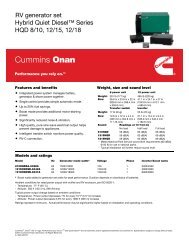Air Brake Manual
Air Brake Manual
Air Brake Manual
You also want an ePaper? Increase the reach of your titles
YUMPU automatically turns print PDFs into web optimized ePapers that Google loves.
Use of <strong>Air</strong> Pressure<br />
Force can also be multiplied by the use of air to gain<br />
further mechanical advantage. Everyone has felt the<br />
force of air on a windy day. <strong>Air</strong> can be compressed<br />
(squeezed) into a much smaller space than it<br />
normally would occupy, for instance, air<br />
compressed in tires to support the weight of a<br />
vehicle. The smaller the space into which air is<br />
squeezed, the greater the air’s resistance to being<br />
squeezed. This resistance creates pressure, which<br />
is used to gain mechanical advantage.<br />
If a constant supply of compressed air is directed<br />
through a pipe that is one inch square, and if a one<br />
inch square plug were placed in the pipe, the<br />
compressed air would push against the plug. A<br />
scale can be used to measure how many pounds of<br />
force are being exerted by the air against the plug.<br />
Leverage and <strong>Air</strong> Pressure<br />
In actual operation, pipes are round and plugs are<br />
diaphragms of flexible material acting against push<br />
rods. If compressed air of 120 psi acts on a<br />
diaphragm of 30 square inches, 3,600 lb of force is<br />
produced (120 x 30). Apply this force to a push rod to<br />
move a 6-inch slack adjuster operating a cam and<br />
the total force equals 21,600 inch pounds torque<br />
(3,600 x 6), or 1,800 foot pounds torque (21,600 ÷ 12).<br />
It requires 25 to 30 foot pounds of torque to tighten<br />
the wheel on a car. This comparison illustrates the<br />
force obtained from using mechanical leverage and<br />
air pressure combined.<br />
30 square inches<br />
120 psi<br />
6 inches<br />
1<br />
inch<br />
Stopping Distance<br />
1 square<br />
inch<br />
10 psi<br />
If the scale registers 10 pounds, for example, then it<br />
could be said the force is 10 pounds on the one<br />
square inch surface of the plug or 10 pounds per<br />
square inch (psi).<br />
The more compressed the air in the supply reservoir,<br />
the greater the force exerted on the face of the plug.<br />
Stopping distance consists of three factors:<br />
· driver’s reaction time<br />
· brake lag<br />
· braking distance<br />
Driver’s reaction time: Reaction time is often called<br />
“thinking time.” The time it takes from the moment a<br />
hazard is recognized to the time the brake is applied,<br />
approximately 3/4 of a second.<br />
<strong>Brake</strong> lag: As air is highly compressible, it requires a<br />
relatively large volume of air to be transmitted from<br />
the reservoir to the brake chamber before there is<br />
enough pressure for the brakes to apply. It can be<br />
8




